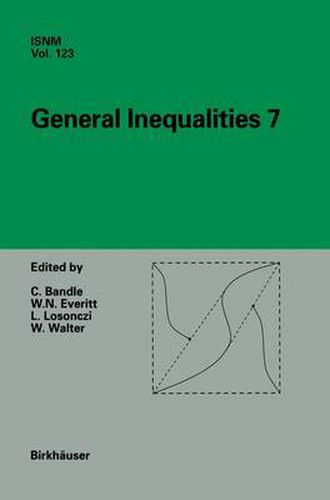Readings Newsletter
Become a Readings Member to make your shopping experience even easier.
Sign in or sign up for free!
You’re not far away from qualifying for FREE standard shipping within Australia
You’ve qualified for FREE standard shipping within Australia
The cart is loading…






This title is printed to order. This book may have been self-published. If so, we cannot guarantee the quality of the content. In the main most books will have gone through the editing process however some may not. We therefore suggest that you be aware of this before ordering this book. If in doubt check either the author or publisher’s details as we are unable to accept any returns unless they are faulty. Please contact us if you have any questions.
Inequalities continue to play an essential role in mathematics. The subject is per haps the last field that is comprehended and used by mathematicians working in all the areas of the discipline of mathematics. Since the seminal work Inequalities (1934) of Hardy, Littlewood and P6lya mathematicians have laboured to extend and sharpen the earlier classical inequalities. New inequalities are discovered ev ery year, some for their intrinsic interest whilst others flow from results obtained in various branches of mathematics. So extensive are these developments that a new mathematical periodical devoted exclusively to inequalities will soon appear; this is the Journal of Inequalities and Applications, to be edited by R. P. Agar wal. Nowadays it is difficult to follow all these developments and because of lack of communication between different groups of specialists many results are often rediscovered several times. Surveys of the present state of the art are therefore in dispensable not only to mathematicians but to the scientific community at large. The study of inequalities reflects the many and various aspects of mathemat ics. There is on the one hand the systematic search for the basic principles and the study of inequalities for their own sake. On the other hand the subject is a source of ingenious ideas and methods that give rise to seemingly elementary but nevertheless serious and challenging problems. There are many applications in a wide variety of fields from mathematical physics to biology and economics.
$9.00 standard shipping within Australia
FREE standard shipping within Australia for orders over $100.00
Express & International shipping calculated at checkout
This title is printed to order. This book may have been self-published. If so, we cannot guarantee the quality of the content. In the main most books will have gone through the editing process however some may not. We therefore suggest that you be aware of this before ordering this book. If in doubt check either the author or publisher’s details as we are unable to accept any returns unless they are faulty. Please contact us if you have any questions.
Inequalities continue to play an essential role in mathematics. The subject is per haps the last field that is comprehended and used by mathematicians working in all the areas of the discipline of mathematics. Since the seminal work Inequalities (1934) of Hardy, Littlewood and P6lya mathematicians have laboured to extend and sharpen the earlier classical inequalities. New inequalities are discovered ev ery year, some for their intrinsic interest whilst others flow from results obtained in various branches of mathematics. So extensive are these developments that a new mathematical periodical devoted exclusively to inequalities will soon appear; this is the Journal of Inequalities and Applications, to be edited by R. P. Agar wal. Nowadays it is difficult to follow all these developments and because of lack of communication between different groups of specialists many results are often rediscovered several times. Surveys of the present state of the art are therefore in dispensable not only to mathematicians but to the scientific community at large. The study of inequalities reflects the many and various aspects of mathemat ics. There is on the one hand the systematic search for the basic principles and the study of inequalities for their own sake. On the other hand the subject is a source of ingenious ideas and methods that give rise to seemingly elementary but nevertheless serious and challenging problems. There are many applications in a wide variety of fields from mathematical physics to biology and economics.